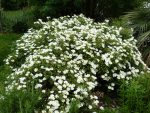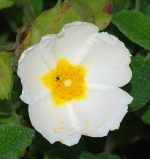A lso known as salvia cistus and Gallipoli rose, this bushy evergreen shrub is native to the Mediterranean region, including southern Europe, parts of Western Asia and North Africa. It is a member of the Cistaceae family, a small group of shrubs and semi shrubs that do well in dry, sunny locations with poor soil. Plants grow 12-24″ tall and have oval, gray- green leaves that are .4-1.5″ long, wrinkled and covered with woolly matted hairs. The flowers appear from spring into summer, are 1.5-2.4″ wide, and have orange yellow stamens in the center surrounded by 5 white petals with a yellow spot at the base. The flowers are very attractive to bees. The whole plant is covered with a sticky fragrant resin. Salvia-leafed rockrose is a good choice for a ground cover, and seaside, rock, gravel, wildlife, and Mediterranean gardens. The genus name Cistus is from the ancient Greek word σθος (kistκίhos) meaning basket. The specific epithet, salviifolius, come from the Latin words salvia the botanical name for sage, and folius meaning leaf, referring to the similar appearance of the leaves to those of sage. Photo Credit ghislain Wikipedia
lso known as salvia cistus and Gallipoli rose, this bushy evergreen shrub is native to the Mediterranean region, including southern Europe, parts of Western Asia and North Africa. It is a member of the Cistaceae family, a small group of shrubs and semi shrubs that do well in dry, sunny locations with poor soil. Plants grow 12-24″ tall and have oval, gray- green leaves that are .4-1.5″ long, wrinkled and covered with woolly matted hairs. The flowers appear from spring into summer, are 1.5-2.4″ wide, and have orange yellow stamens in the center surrounded by 5 white petals with a yellow spot at the base. The flowers are very attractive to bees. The whole plant is covered with a sticky fragrant resin. Salvia-leafed rockrose is a good choice for a ground cover, and seaside, rock, gravel, wildlife, and Mediterranean gardens. The genus name Cistus is from the ancient Greek word σθος (kistκίhos) meaning basket. The specific epithet, salviifolius, come from the Latin words salvia the botanical name for sage, and folius meaning leaf, referring to the similar appearance of the leaves to those of sage. Photo Credit ghislain Wikipedia
 Type: Flowering evergreen shrub
Type: Flowering evergreen shrub
Outstanding Feature: Flowers
Form: Mound
Growth Rate: Rapid
Bloom: White flowers with 5 petals and yellow centers from late spring into summer
Size: 12-24″ H x up to 2.7′ W
Light: Full sun
Soil: Lean, loose, coarse, very well-drained; needs cool roots; tolerates drought and maritime exposure.
Hardiness: Zones 8-10
Care: Mulch in summer to keep roots cool. Tip prune to encourage bushiness; does not do well with hard prunning.
Pests and Diseases: None of significance; resistant to honey fungus.
Propagation: Seed, softwood cutting
Outstanding Selections: ‘Prostratus’
Photo Credit:Wikipedia